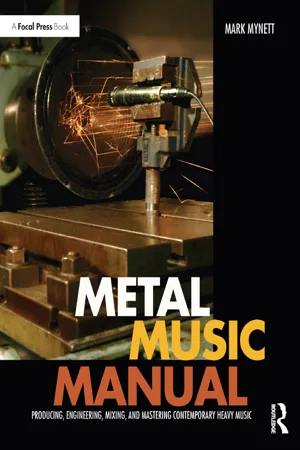If you are reading this book, it’s likely you have a passion for metal music, and more specifically metal music production. Welcome—you’ve come to the right place! From rehearsal room through to final mastered product, this manual presents—in meticulous detail—the technical and creative processes for the production of contemporary heavy music to a professional standard.
This is an inspiring time to be writing a book on the subject. Metal music has demonstrated the longevity of its appeal by existing for almost half a century. However, it is only in the past 10 years or so that the genre has gained broad cultural acceptance. This is reflected by an increased integration into mainstream media that previously focused solely on rock, indie, and pop. Similarly, many news publications that once reflected a negative stigma toward metal music now provide continued positive coverage, with the genre now acknowledged as a challenging and highly compelling art form.
These developments have been accompanied by a dramatic increase in the research and study of the genre. Typing “heavy metal” into Amazon’s search engine reveals literally thousands of volumes that have been published on the subject. These titles tend to address the importance and relevance of metal from historical, sociological, cultural, and musicological perspectives. From heavy metal-inspired cookbooks, through to extensive studies on Islamic metal, there is an incredible diversity of publications. However, at the time of writing, there isn’t a single book dedicated to the production of the music itself!
It is important to ask why a music production manual is needed for the contemporary metal style. Isn’t the process pretty much the same as for other forms of popular music with the same instrumentation? The categorical answer is no, it most definitely is not. In brief: we’re dealing with a sonically dense wall of distorted down-tuned guitars that heavily obscure the other instruments. And often fast, rhythmically synchronized kick/bass/guitar subdivisions, resulting in quickly recurring slow low-frequency wavelengths, and several times more musical events per song than typically involved in other genres.
In simple terms, then, this production style involves capturing and translating a dense concentration of musical sound—usually referred to as “heaviness.” However, there is a paradox; this defining feature of “heaviness” is also at the core of the challenges involved. If the qualities that equate to heaviness are not sufficiently controlled, the performances and sounds lack clarity. A lack of clarity results in less effective heaviness, as the music’s energy, aggression, and impact are lost in what becomes an unintelligible mush. For example, the rhythm patterns of the all-important guitar riffs get blurred, and the complexity involved in the performances just ends up sounding confused and messy. For other genres, an uncontrolled, unintelligible mush might adequately translate the emotional message of the music, but this is seldom the case here. When presented with poor clarity, this is a style of music that is usually considered unacceptable.
For these reasons, this manual does not address lo-fi production values in any way. Similarly, it is not intended as a simplistic “101” for achieving a good-quality demo. Its objectives are to present the approaches, processes, and techniques involved in producing contemporary heavy music for maximum sonic impact. This is enabled through an appropriate balance between heaviness, sonic weight, clarity, and performance precision. Different productions need these key characteristics emphasized in entirely different ways, but a production that is deficient in all four areas is inevitably weak.
AUDIO
Many of the engineering and processing images in this manual come from real-world projects, which you are able to access via the companion website (www.routledge.com/cw/Mynett). Listed below, these 10 productions represent a particularly diverse range of performance styles, from extreme metal through to slower/groove-based heaviness. Each track was produced, engineered, mixed, and mastered by the author. But to provide a broader range of mix challenges, they reflect varied production budgets, performance standards, and recording environments—and two multitracks have been included (marked §) that feature drums and vocals recorded by the bands themselves.
• For Untold Reasons—“Of the Skies”
• Godsized—“Fight and Survive”
• Motherload—“We Are the Authority”
• Everything for Some—“Just Like Jesse James”
• All That Fall—“Ripped at the Seams”
• K2—“Sleeper Cell”
• Sintax—“The Answer” §
• City of God—“Requiem”
• Kaizen—“Time and Tide”
The complete multitracks, full session details (tempo maps etc.), and final mastered/unmastered mixes are provided, as well as stems, clean DIs for re-amping or amp-sim use, pre/post processing examples, and downloadable software mix settings. With some, a multitrack of clean drum hits taken from the kit used for tracking is available, allowing you to create samples from these hits.
Production and mix examples from these projects are referred to throughout this book. As you read through, you are encouraged to access these files and experiment with the concepts and techniques you read about. Due to the high number of audio examples available, many are not listed within the book, however the following prompt is provided when relevant:
Audio examples referenced within these boxes can be accessed via the companion website (www.routledge.com/cw/Mynett), which are organized in folders by chapter.
VIDEO INTERVIEWS
The book’s companion website also provides access to video interviews the author conducted with the following acclaimed producers, who share their expertise, experience, and insight into the processes involved:
• Ross Robinson (Slipknot, Sepultura, Machine Head)
• Fredrik Nordström (Dimmu Borgir, At the Gates, In Flames)
• Matt Hyde (Slayer, Parkway Drive, Children of Bodom)
• Logan Mader (Gojira, DevilDriver, Fear Factory)
• Andy Sneap (Megadeth, Killswitch Engage, Testament)
• Jens Bogren (Opeth, Kreator, Arch Enemy)
• Daniel Bergstrand (Meshuggah, Soilwork, Behemoth)
• Nick Raskulinecz (Mastodon, Death Angel, Trivium)
Quotes from these interviews are featured throughout ...

